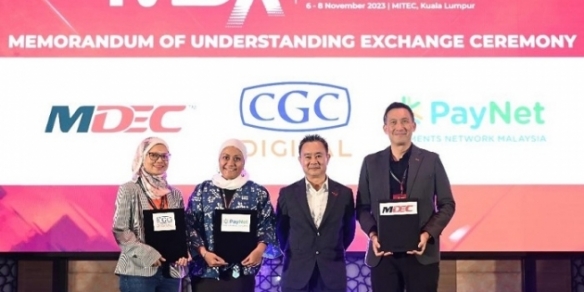Telco Deep Dive: Consumers value performance over price
By Karamjit Singh June 12, 2014
On May 26, Digital News Asia (DNA) released its first Deep Dive report, which looked at the telecommunications space in Malaysia. Over these next two weeks, we will be publishing the articles from the PDF report on our portal, plus other stories. To download the Telco Deep Dive, click here. In this article, DNA founder Karamjit Singh looks at the big changes afoot in the mobile telco space, with consumers now placing performance over price for the first time, and with vendors pushing to ‘cloudify’ their networks.
- Increasing video, app usage driving need for better networks
- Indoor coverage more important, vendors innovating to deliver

THE senior management team of leading telco vendor Ericsson was in town in March to sign a major deal with Celcom Axiata Bhd.
Celcom is aiming to enhance its network, with an eye towards delivering a better customer experience.
That customer experience, today, is increasingly data driven, with users worldwide, especially in advanced economies, consuming a lot more video on their mobile devices, the performance of which thus dictates their user experience.
Ericsson is not short of data that supports this trend towards video, with Magnus Mandersson (pic above), executive vice president and head of its Business Unit Global Services, saying that 40% of mobile traffic today consists of video.
That is the global average, and it is much higher in advanced markets.
And while it is no surprise when Johan Wibergh, also an executive vice president and head of its Business Unit Networks, says video is very important, Ericsson projects that over the coming six years, video traffic per user will grow six times, from the present 600MB per user to 2.2GB in 2019.
What really seems to excite both gentlemen, who report directly to Ericsson chief executive officer Hans Vestbergh, is the fact that the world will go from the current base of fewer than two billion mobile broadband subscriptions to possibly hitting eight billion (some users will have multiple subscriptions) in 2019.
“This will change the world! When mobile broadband is available everywhere,” declares Wibergh.
Performance trumps price
With video experience increasingly becoming the main factor that determines a user’s mobile experience, it is no surprise that the latest data in Ericsson’s annual Mobility Report, shows that consumers see performance as being twice as important as price/ value for money.
This shows a significant shift in how consumers now rate their mobile experiences.
As Wibergh points out, “This is the first time in the history of the report that this has happened, with smartphones being the catalyst to drive the shift to data from voice.”
As the executive who leads Ericsson’s 24,000-strong global research and development (R&D) unit with a US$5-billion (RM16.2-billion) budget, Wibergh’s team is tasked with delivering innovation and performance in the increasingly complex networks that are needed to meet consumers’ user experience.
“To achieve this performance that users expect, we are not just talking about great outdoor and indoor coverage and high quality operations, we also have a new trend where mobile operators now talk of delivering on ‘app coverage’ for their customers,” he says.
Different apps need different coverage and faced with the reality that the consumer experience is increasingly app-driven, mobile operators today talk about how they can deliver the coverage for these apps and their performance in different places.
While over the past two decades, vendors have focused on improving the outdoor reception and experience, with smartphones and tablets increasingly being the preferred medium to interact with the Internet and with apps, indoor coverage and user experience have become critical.
 For instance, Mandersson paints a scenario where in the future, every cell site could have 200 apps interacting with the network, from the average of 15 today.
For instance, Mandersson paints a scenario where in the future, every cell site could have 200 apps interacting with the network, from the average of 15 today.
“Over the past 20 years, we have invested on building great coverage outdoors but in the coming years, this will change as we bring that outdoor experience inside,” says Wibergh (pic), pointing to the Radio Dot System Ericsson introduced recently, designed to improve indoor coverage and capacity.
While there has been much talk about how mobile operators should handle the challenge from Internet players who deliver OTT (over the top) services over mobile networks while bypassing operators, Mandersson does not think it is a case of one party winning at the expense of the other.
“Consumers will choose what they want and on how they interact with their apps,” he says.
“Sometimes, they may not want to pay for the experience, and other times they may want to. On our part, we have to build our networks to ensure operators can offer the best service possible so consumers will interact with their apps via the operators’ networks [through specific app packages] rather than OTT players.”
One interesting trend happening on the network side, that will put power in the hands of the consumer, is what Wibergh calls ‘cloudifying’ the networks. This is basically a software-driven revolution that will enable telco networks to become more agile in offering new services and products to the market.
The result will be that the market will move away from packages the operators offer customers, to customers picking what they want, be it voice, data, MMS (multimedia messaging) or any other service.
“This will open up new behavioural patterns with customers, and those operators that can offer these tailor-made services will have a great advantage,” predicts Mandersson.
Related Stories:
Global 4G/LTE divide will be wide in 2019: Ericsson Mobility Report
Ericsson unveils the ‘Dot,’ says it redefines small cell market
Internet usage, mobility altering Asia Pacific online trends: Forrester
Telenor’s Asia CEO Brekke on OTT and spectrum re-farming
For more technology news and the latest updates, follow us on Twitter, LinkedIn or Like us on Facebook.


